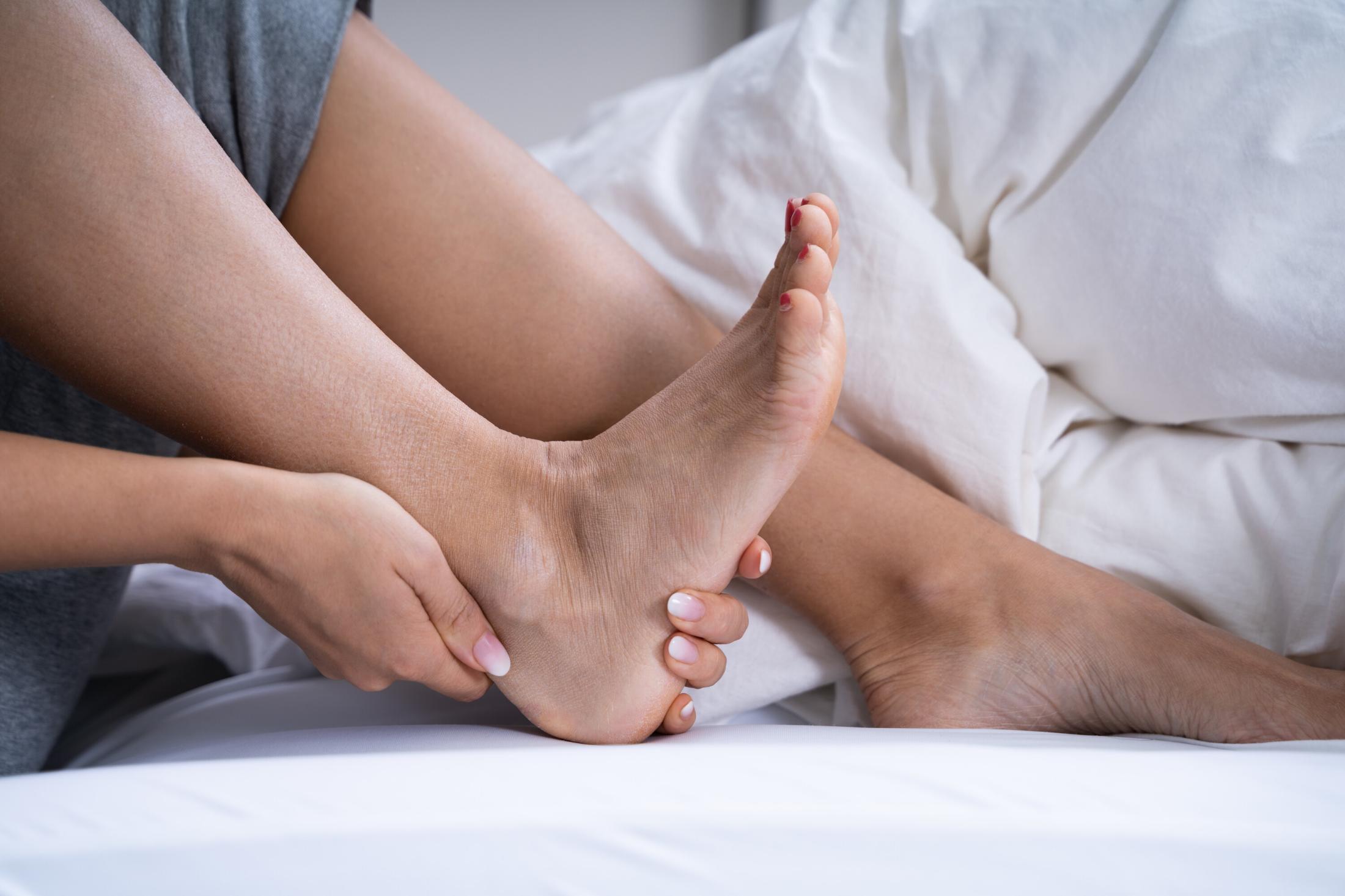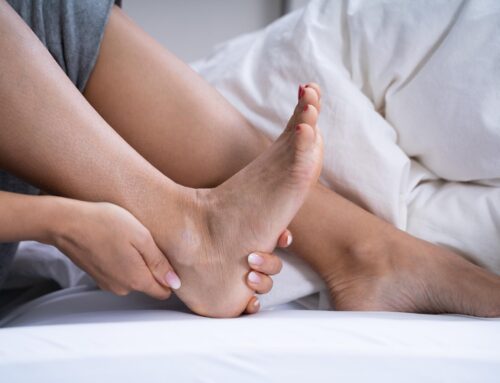Chronic foot pain is more than just an occasional ache, it’s a persistent, often exhausting discomfort that can interfere with how you walk, work, exercise, and rest. For some, it begins with a sharp jolt of heel pain in the morning; for others, it’s a steady, throbbing ache that intensifies as the day wears on. Over time, this kind of pain can quietly erode your quality of life.
Despite how common it is, many people live with chronic foot pain without ever addressing the underlying cause. Some try to push through the discomfort, relying on painkillers or avoiding certain activities altogether. But masking the symptoms rarely solves the problem and often leads to worsening pain, poor posture, or new injuries caused by overcompensation.
Here’s the encouraging part: there are proven, non-surgical ways to find real relief.
What Causes Chronic Foot Pain?
Chronic foot pain doesn’t appear out of nowhere. In most cases, it’s the result of an underlying issue that’s been developing over time, even if the pain seems to have appeared suddenly.
Plantar Fasciitis
One of the most common culprits, plantar fasciitis involves inflammation of the thick band of tissue that runs along the bottom of the foot. It often causes sharp heel pain, especially with the first few steps in the morning or after long periods of rest.
Flat Feet or Fallen Arches
When your arches collapse or don’t develop properly, your feet lose their natural shock absorption. This can put extra stress on muscles, joints, and ligaments, leading to persistent pain and fatigue.
Overpronation or Supination
Your foot mechanics, how your foot rolls as you walk or run, play a huge part in pain development. Overpronation (excessive inward rolling) or supination (not rolling in enough) can create uneven pressure, strain joints, and throw off alignment from the feet upward.
Arthritis or Joint Degeneration
Osteoarthritis, rheumatoid arthritis, and other degenerative conditions can break down cartilage in the feet over time, resulting in stiffness, inflammation, and long-term discomfort that often worsens with age.
Previous Injury or Trauma
Old sprains, fractures, or tendon injuries, even if they seemed minor at the time, can leave behind imbalances, scar tissue, or chronic inflammation that flares up long after the initial injury has healed.
Too often, foot pain is managed with quick fixes like rest, painkillers, or a new pair of shoes. While these may offer short-term relief, they rarely address the real issue. Without tackling the root cause, the pain tends to return, or gradually worsen over time.
An accurate diagnosis is important for meaningful, long-term results. Chronic foot pain can stem from biomechanical imbalances, structural issues, or underlying inflammation. Identifying the true source is what makes it possible to choose the most effective treatment and finally move beyond temporary solutions to lasting relief.
Why Traditional Treatments Often Fall Short
When chronic foot pain becomes a daily struggle, many people turn to what they believe are their only options: surgery, prescription medications, or repeated cortisone injections. While these conventional treatments can provide short-term relief, they often come with limitations that make them less ideal for long-term recovery.
Surgery Isn’t Always the Best First Step
Foot surgery is invasive by nature and typically reserved for severe or structural issues. Even when successful, it usually involves a long recovery period, post-operative pain, and time off work or regular activities. There’s also no guarantee the pain won’t return if the root cause, like improper biomechanics or poor footwear, isn’t addressed.
Surgery is also costly. Between specialist consultations, imaging, hospital fees, and rehabilitation, the price tag can be significant, especially for a procedure that may not resolve the problem completely.
The Quick Fix: Painkillers and Injections
Over-the-counter medications and corticosteroid injections can reduce inflammation and dull the pain, but they don’t correct the underlying issue. In fact, masking pain often leads people to continue habits or movements that worsen their condition over time.
Long-term use of painkillers, especially NSAIDs, can strain your digestive system, liver, or kidneys. Repeated steroid injections may weaken tissue and even lead to further degeneration if overused.
Relief Should Be More Than Temporary
The goal shouldn’t be to just feel better for now, it should be to restore comfort and function for the long term. Lasting relief from chronic foot pain comes from identifying and treating the actual cause, not just numbing the symptoms. That’s where non-invasive, proactive strategies can make all the difference.
Non-Surgical Options for Chronic Foot Pain
Relieving chronic foot pain doesn’t have to mean going under the knife or relying on a lifetime of medications. Many people find lasting relief through non-surgical, drug-free methods that target the source of their discomfort instead of just the symptoms. These conservative approaches focus on improving alignment, reducing strain, and supporting natural movement, all of which can significantly improve quality of life.
Custom-Fit Foot Supports
One of the most effective ways to manage ongoing foot pain is with custom foot orthotics. These aren’t your average drugstore inserts, they’re designed to match your unique foot structure, walking pattern, and pressure points. By improving alignment and redistributing weight evenly across the foot, custom-fit supports can ease strain on sore areas and correct issues like overpronation or uneven gait.
Properly fitted inserts can also provide cushioning where it’s most needed, helping to absorb impact with each step and reduce irritation in problem zones like the heel, arch, or forefoot. When used consistently, they not only relieve existing pain but help prevent further stress-related injuries from developing.
Supportive Footwear
Ill-fitting or unsupportive shoes can contribute to poor posture, overuse injuries, and long-term joint strain. Look for supportive shoes that offer:
- Firm arch support to reduce collapse and fatigue
- Cushioned heels to absorb shock
- A wide toe box to prevent pinching and allow natural toe spread
It’s also important to limit time in shoes that prioritize fashion over function, such as high heels, narrow dress shoes, or flip-flops with zero support. Even wearing the right shoes for a few hours a day can begin to make a noticeable difference.
Physical Therapy & Stretching
Targeted physical therapy can be a relieve chronic foot pain. Strengthening key muscle groups, particularly those in the feet, ankles, calves, and hips, helps improve stability and reduce the risk of compensation injuries.
Gentle stretching also helps reduce stiffness and improves range of motion. Simple routines like calf stretches, toe flexes, and plantar fascia rolls can be done at home daily, with minimal time or equipment required.
Massage, Myofascial Release & Acupressure
Hands-on therapies can significantly ease chronic foot pain, especially when caused by muscle tightness or soft tissue restrictions. Massage and myofascial release techniques help improve circulation, release trigger points, and promote healing.
At-home tools like massage rollers, lacrosse balls, or even a frozen water bottle can be used to roll out tight spots along the arch or heel. For those who prefer a guided approach, professional massage or reflexology sessions may offer even deeper relief.
Lifestyle Adjustments
Sometimes, small changes in daily habits can make a big difference. Managing body weight reduces the load on your feet and joints. Practicing good posture, especially during long periods of standing or walking, helps improve overall alignment and movement patterns.
It’s also important to balance activity with adequate rest. Overuse, especially without proper support or recovery time, is one of the most common contributors to chronic foot pain. Listening to your body and making time for recovery is just as important as the treatment itself.
When to Seek Professional Help for Chronic Foot Pain
While many cases of chronic foot pain can be improved with self-care and lifestyle changes, there comes a point where professional support becomes essential. Persistent pain is your body’s way of signaling that something isn’t working as it should and ignoring it can lead to bigger problems down the line.
Red Flags You Shouldn’t Ignore
If you’re experiencing any of the following, it’s time to consult a qualified healthcare provider:
- Pain that lasts longer than a few weeks, even with rest or home treatment
- Pain that interferes with walking, work, or daily routines
- Numbness, tingling, or burning sensations in the feet or toes
- Visible changes in foot structure, arch height, or joint alignment
- Recurring swelling or inflammation, especially in one specific area
- Pain that’s worsening, spreading, or triggering new symptoms in the knees, hips, or back
Chronic foot pain often starts as a manageable issue but can escalate if the root cause goes unaddressed. Early intervention is imprortant and a Chiropodist Foot Assessment is a smart place to start. A licensed chiropodist can evaluate your foot mechanics, identify structural or pressure-related problems, and recommend targeted, non-surgical solutions to help relieve your pain before it worsens.
Who Can Help
Seeking care from a foot specialist doesn’t mean you’re heading straight to surgery. In fact, most foot professionals focus on conservative, non-invasive treatments first.
- Podiatrists are medical doctors who specialize in diagnosing and treating foot and ankle disorders. They can assess structural issues, perform imaging, prescribe custom solutions, and manage chronic conditions like arthritis or plantar fasciitis.
- Chiropodists (commonly licensed in Ontario and other regions) offer foot-focused care that includes gait analysis, hands-on treatments, and preventive strategies to reduce strain and improve mobility.
- Physiotherapists help address biomechanical imbalances and guide you through tailored exercises to strengthen supporting muscles, improve range of motion, and correct movement patterns contributing to pain.
Each of these professionals brings a unique skill set, and in many cases, a collaborative approach delivers the best results, especially when dealing with complex or long-term foot pain.
Relief Is Possible Without Surgery or Medication
Living with chronic foot pain can be frustrating, exhausting, and often discouraging, but lasting relief is possible without resorting to surgery or long-term medication use. With the right combination of personalized support, targeted therapies, and lifestyle adjustments, many people experience meaningful improvements in both comfort and mobility.
The key is early intervention and consistency. Addressing foot pain before it worsens, rather than pushing through it or relying on temporary fixes, can prevent further complications and help restore your quality of life. Even small changes, like switching to properly supportive footwear or incorporating daily stretching, can make a noticeable difference when applied consistently.
At Care-Med, we take a personalized, non-invasive approach to foot health. If chronic foot pain is limiting your day-to-day life, we’re here to help. Whether you need expert advice, a professional foot assessment, or access to custom-fit solutions, our team is ready to guide you toward a treatment plan that works for your lifestyle and goals.
Share This Story, Choose Your Platform!
Table of Contents
We specialize in orthotics, body braces, and compression wear tailored to your unique needs in Toronto. Reach out to us at info@caremed.care or call 416-782-5353 to book your fitting and consultation.
Experience the difference of customized solutions designed just for you.











